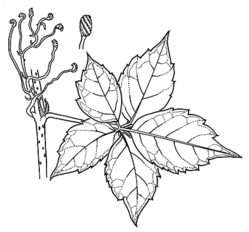Common name: Virginia Creeper, Five-leaved Ivy
Parthenocissus quinquefolia Planch. APNI* 
Description: Woody vine, glabrous to sparsely pubescent, with new growth pink to purplish; tendrils 5–12-branched, apices expanded into adhesive discs. Spreads over the ground and climbs vegetation and other surfaces.
Leaves palmately compound; leaflets 5, elliptic to ovate or obovate, 2–11 cm long, 1–6.5 cm wide, apex acuminate, base cuneate, margins regularly and coarsely toothed, glabrous, upper surface dull green, lower surface paler and ± glaucous; petiole 3–15 cm long, petiolules 5–25 mm long.
Inflorescence spreading, shorter than the leaves. Petals 1–2 mm long, greenish.
Fruit ± globose, 3–5 mm diam., bluish black.
Flowering: late spring to summer.
Distribution and occurrence: Commonly grown as an ornamental creeper; sometimes naturalised in the Sydney area and occasionally elsewhere. Garden escape into native bushland and disturbed areas.
NSW subdivisions: *NC, *CC, *ST
Able to climb smooth surfaces using forked tendrils tipped with small adhesive pads. The berries contain oxalic acid and are poisonous to humans and other mammals. They are edible to birds. The sap can cause irritation and skin rash.
Text by G. J. Harden (last edited by P.G. Kodela, Jan 2010)
Taxon concept: Flora of NSW 3 (1992)
APNI* Provides a link to the Australian Plant Name Index (hosted by the Australian National Botanic Gardens) for comprehensive bibliographic data
***The AVH map option provides a detailed interactive Australia wide distribution map drawn from collections held by all major Australian herbaria participating in the Australian Virtual Herbarium project.
|


